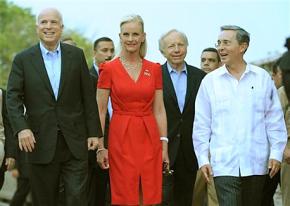Behind the Colombia hostage rescue
explains how U.S. weapons and training for the Colombian military has changed the balance in the country's civil war--and set a precedent for projecting American power in Latin America.
THE REPUBLICAN presidential nominee visits Colombia to meet with President Alvaro Uribe (virtually the only South American leader who has a kind word to say to him) on the very day that the Colombian military--bloated with billions of dollars in equipment provided by the U.S. government--pulls off a major public relations coup by rescuing former presidential candidate Íngrid Betancourt, three American mercenaries and a dozen more hostages from the Revolutionary Armed Forces of Colombia (FARC).
But it's all a big coincidence--at least according to crack investigative journalist Judith Bumiller, traveling with McCain for the New York Times.
"The timing of the rescue, which occurred while Mr. McCain was in Colombia, was in many ways a fortuitous turn of events for a presidential candidate who is using a three-day trip to South America and Mexico to try to show that he is a more agile foreign policy hand than his Democratic competitor, Senator Barack Obama," Bumiller wrote.
"Although the timing of the rescue was a coincidence and Mr. McCain's trip to Colombia had nothing to do with it, the event nonetheless put him in the middle of classified talks about covert operations with the head of another government."

"Fortuitous" indeed! In fact, the Bush administration helped plan the operation and provided unspecified material support. And Uribe even briefed McCain (and his traveling companion, Sen. Joseph Lieberman) on plans for the raid before it took place.
There is even speculation that Uribe was able to pull off the rescue--in which soldiers impersonated FARC guerrillas--precisely because the French government was in the process of securing Betancourt's release and had been in negotiations with FARC commanders.
Whether or not this turns out to be the case, it stretches the bounds of credulity to believe that Bush did not tip off McCain to the impending operation, allowing him to don his Navy cap and strike a pose on a Columbian anti-narcotics military vessel, while basking in Uribe's international media limelight.
THE FARC's decision to kidnap Betancourt in hopes of exchanging her for rebel prisoners was a tactical blunder of the first order. However, the FARC's policy must be understood in the context of the overwhelming brutality of the American-armed Colombian government. According to Human Rights Watch, since 1986, the Colombian military and its associated paramilitary death squads have murdered more than 2,500 trade unionists.
Recently, the FARC has come under intense pressure to negotiate an end to the civil war and is listed as a "terrorist" organization by the U.S. government--a label most American media sources, not to mention mainstream Democrats like presidential candidate Barack Obama, repeat without comment.
However, the FARC's reluctance to disarm is certainly understandable. In the mid-1980s, many of the group's members agreed to lay down their weapons and take part in elections in a leftist coalition called the Patriot Union. In exchange for their participation in the "democratic process," up to 5,000 of them were systematically exterminated by the military and its death squads, including 1990 presidential candidate, Bernardo Jaramillo Ossa.
Despite this bloody history, President Bill Clinton initiated "Plan Colombia" during his second term in office. Between 1996 and 2000, Clinton increased aid to the Colombian military by nearly 14 times, from $54 million to $765 million. George Bush has sent between $400 million and $650 million in military aid to Colombia every year of his presidency.
This avalanche of arms has made the Colombian military one of the mightiest in the region, far more powerful than the Venezuelan military, for instance. And it has also turned the tide in the civil war, driving FARC guerrillas deeper and deeper into the mountains and reducing their fighting force from more than 15,000 10 years ago to an estimated 6,000 to 8,000 today.
Whether or not Uribe pre-empted the French-brokered release of Betancourt, it is clear that the FARC is in trouble, and the Colombian government believes that, if it cannot military win the war in the next few years, it can certainly continue to press its advantage.
Furthermore, the Colombian military's incursion into Ecuador earlier this spring "in pursuit" of FARC rebels sets a dangerous precedent.
As Latin America turns left, U.S. imperialism is searching for the means to regain the strategic advantage in "its backyard." Boosting Colombia's military capacity is not just about defeating the FARC or fighting the "war on drugs." It is also about sending a bipartisan message to Colombia's unruly neighbors that the U.S. aims to play an increasingly intrusive role in the region's future.


